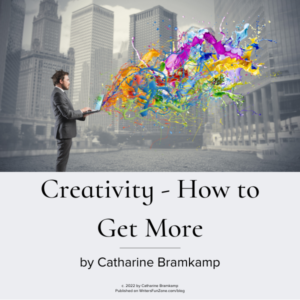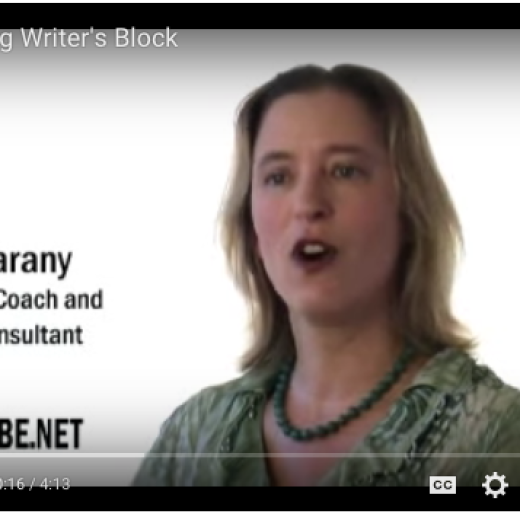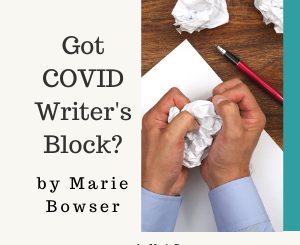Creativity – How to Get More by Catharine Bramkamp
 Let’s welcome back monthly columnist Catharine Bramkamp as she shares with us “Creativity – How to Get More.” Enjoy!
Let’s welcome back monthly columnist Catharine Bramkamp as she shares with us “Creativity – How to Get More.” Enjoy!
***
We’ve all been reading feeds with the word creativity in the headline:
How to be more Creative
Interview for Creative Employees
The Creative CEO.
It seems that creativity is the new, new thing.
And like all new things – it has an old history.
Ever since the afternoon someone hummed a tune that didn’t sound like the local bird calls, humans have questioned, studied and pursued creativity which led to more questions and varied answers.
Creativity is thinking outside the cave.
It’s science.
It’s progress.
It’s tasting the meat accidentally dropped in the fire and finding it more palatal.
But no matter how it’s defined, creativity and the pursuit of inspiration is essential to the life of an artist.
But what, exactly, is creativity?
The Origins of Creativity
As it turns out, the definition depends on when creativity is defined.
Greek philosophers and poets believed that creativity was a gift from the gods.
One of the nine muses delivered the inspiration, and the poet memorized (later transcribed) his or her version of that inspiration. Creativity as a product of divine inspiration held sway for many millennium.
By the 1600’s pure inspiration from the gods was edged out by science.
Natural philosophers wanted to know how the world worked, and the creative process was not exempt from their scrutiny.
The Enlightenment
By the 1700s and the Enlightenment, philosophers concluded that creativity could be achieved by following a specific process.
Charles Batteaux commented that imagination was merely the result of observed phenomena.
“The human mind cannot create, strictly speaking; all its products bear the stigmata of their model; even monsters invented by an imagination unhampered by laws can only be composed of parts taken from nature.”
So imagination was little more than working those three part flip boards – the legs of a lion, the middle of a turtle and the head of a phoenix – now you have a new beast, but you only worked from known images.
Concurrently, Denis Diderot (who created the first encyclopedia) felt that imagination was merely “the memory of forms and contents. . . and creates nothing rather only combines, magnifies or diminishes.”
Forget divine inspiration, like most Enlightenment ideals, creativity followed rules:
Since creation is defined as creating something out of nothing, and only God can create something out of nothing, then pure creativity is impossible for man to achieve.
Creation is a mystery, and mystery negates the whole POINT of the Enlightenment which was to never admit there were any mysteries left.
To that end, artists working during the late 18th century were all about rules, if you don’t follow the rules of painting or writing a sonnet or composing a sonata: no soup for you.
Except as Houdar de la Motte (d.1715) commented– rules are ultimately a human invention. and how much imagination and invention did it take to create these artistic rules?
Things were ripe for change.
Romanticism
By the mid-nineteenth century, the cold science of the Enlightenment was warmed up by the hot passion of the Romantic movement.
Instead of science, artists embraced communing and expressing the mystical, painting the impossible, experiencing the divine and feelings of awe.
However, there still remained a strong desire to figure out how it was done.
Henri Poincare – (1854 – 1912) a mathematician by trade and propensity, proposed that creativity happened in four stages:
- Preparation: The artist sets out intentions and defines the goals.
- Incubation: The artist dreams into the possibilities, honors the unknown and becomes receptive to what is seeking him (or her, remember this is the Victorian age – it’s mostly about men).
- Illumination: The artist has the revelation in which some new possibilities take shape.
- Execution: The artist creates, manifesting and materializing his discovery.
Great, another system.
Modern Thought
It wasn’t until the 21st century that scientists, mapping and studying brain activities realized that little of creativity followed a discernable pattern.
Ever.
Jacob Nordby in his book The Creative Cure, proposed that “Creativity is not orderly, nor does it easily break down into clear steps reaching up to heaven or enlightenment.”
In other words, creativity is messy.
Nordby writes that instead of trying to break creativity into easy to follow steps, consider that often there are three components to creativity: loving, knowing, and doing.
But these components do not fit together like legos, they connect and refer back to themselves, like Tinker Toys.
How do we view creativity today?
We understand and support the concept that imagination is personal – each of us does it differently.
If that is so, then it is not necessary to follow a path or a system.
We also understand that creativity is internal.
We create on purpose and we don’t need any outside tools to do it.
That said, there is a movement to return to the idea of courting and attracting the Muse.
Full circle.
How can we attract the muse and inspiration? Or better, how can we get back into the groove after a holiday, vacation or crisis?
Choose a project. Just launch into it.
Don’t prepare, don’t try to follow any rules, just go. See what happens.
Learn something new.
The beginner’s mind, and the concentration it takes to master a new activity or technique can often enhance and inspire you to return to a beloved project, with a fresh perspective.
Spend time with masters of your art: read a great novel, visit an art museum, attend a concert.
Allow for inspiration.
What could possibly block our creativity?
Socialization, which right now means Social Media.
Humans automatically follow cultural norms.
We spend most of our days first learning, then following the rules of socialization, so much so that we may as well be operating under the weight of Enlightenment style rules.
Worse, since WWII, we as a society have been gradually transformed from Humans into Consumers.
We spend our days following an elaborate call and response:
I read that I am not good enough. To become good enough, I need to purchase this product. Later I read that the recently purchased solution that made me good enough yesterday will not do today and I need to purchase this new, new solution.
This destructive cycle is very bad for your creative soul.
Create your own call and response:
- Step away from Social Media
- Take a break from constant consumption
- Breath and feel what it’s like to be yourself, enough.
From that space:
- Court the Muse – which means you show up consistently, daily, and create as best you can, as often as you can. When you work, the inspiration (the whispering Muse in your ear) will arrive and help.
- Do a new thing very badly.
- Work on a number of projects simultaneously. If one project isn’t working, just leave it and work on the other project. It’s perfectly okay to have a number of creative projects all out on the table at once.
How ever you approach it, creativity, and the random seemingly pointless activities that feed the process, is important.
Without random acts of creativity we’d still be crouched around a small fire gnawing on large chunks of raw meat with nothing to say.
Learn more on how to Increase Your Creativity with my new online class: https://catharine-bramkamp.com/lp-courses-2
***
Want to read more articles like this one Writer’s Fun Zone? Subscribe here.
***
ABOUT THE AUTHOR
 Catharine Bramkamp is a successful writing coach, Chief Storytelling Officer, former co-producer of Newbie Writers Podcast, and author of a dozen books including the Real Estate Diva Mysteries series, and The Future Girls series. She holds two degrees in English and is an adjunct university professor. After fracturing her wrist, she has figured out there is very little she is able to do with one hand tied behind her back.
Catharine Bramkamp is a successful writing coach, Chief Storytelling Officer, former co-producer of Newbie Writers Podcast, and author of a dozen books including the Real Estate Diva Mysteries series, and The Future Girls series. She holds two degrees in English and is an adjunct university professor. After fracturing her wrist, she has figured out there is very little she is able to do with one hand tied behind her back.
Similar Articles
https://writersfunzone.com/blog/2020/06/24/re-source-from-the-source-of-creativity-by-beth-barany







Excellent, excellent, excellent. What a well-researched and thought-out discussion of creativity, the different views of it, and the evolution of how it’s perceived over time. This is a bookmarked article for sure.
Thank you Hugh!
I am fascinated by how creativity works in our brains and in our lives, I’ll be writing more about it in future posts.
Best,
Catharine